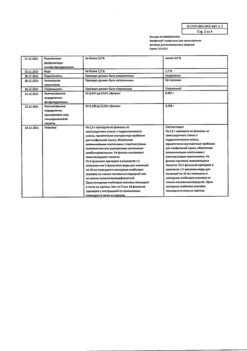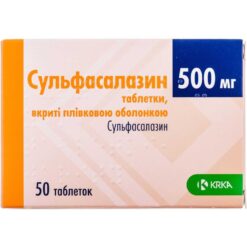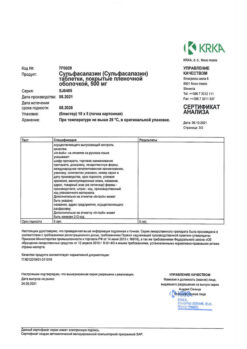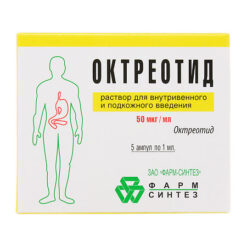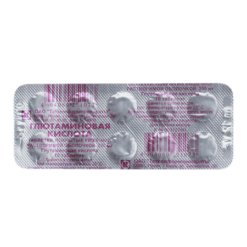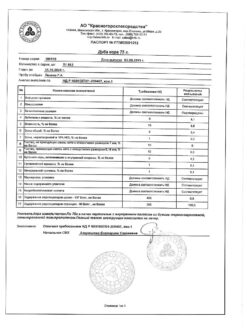No products in the cart.
Fosfogliv URSO, 35 mg+250 mg capsules 50 pcs
€24.48 €23.96
Description
Pharmacotherapeutic group: drugs for the treatment of the liver and biliary tract in combination.
ATX code: A05C
Pharmacological properties.
Pharmacodynamics
Combined drug, hepatoprotective agent, also has choleretic, cholitholytic, antioxidant, anti-inflammatory actions, affects fibrogenesis.
Ursodeoxycholic acid
Ursodeoxycholic acid has a choleretic effect. It reduces the synthesis of cholesterol in the liver, its absorption in the intestine and its concentration in the bile, increases the solubility of cholesterol in the biliary system, stimulates the formation and excretion of bile. It decreases bile lithogenicity and increases bile acids content; it causes intensification of gastric and pancreatic secretion, increases lipase activity and has hypoglycemic effect. Causes partial or complete dissolution of cholesterol stones in enteral administration, reduces bile saturation with cholesterol, which promotes mobilization of cholesterol from gallstones. It has immunomodulatory effect, influences immunological reactions in the liver: it decreases the expression of some antigens on the membrane of hepatocytes, affects the number of T-lymphocytes, formation of introleukin-2, decreases the number of eosinophils.
Glycyrrhizic acid
It has a hepatoprotective effect due to antioxidant, anti-inflammatory effects, and effects on fibrogenesis.
Glycyrrhizic acid binds free oxygen radicals and inhibits enzymes that initiate lipid peroxidation (LPO) in hepatocytes.
Glycyrrhizic acid reduces inflammation through its inhibitory effect on NF-kB- and TLR4-signaling pathways; inhibition of pro-inflammatory cytokine production (TNF α, IL-1, IL-6, IL-8); stimulation of anti-inflammatory cytokine production (IL-2, IL-10, IL-12). Glycyrrhizic acid inhibits 11β-oxysteroid dehydrogenase, which increases endogenous cortisol in the blood (pseudocorticosteroid effect).
The effect on fibrogenesis is associated with reduction of collagen type 1 gene expression and reduction of collagen production by stellate liver cells (Ito cells), as well as destruction of activated Ito cells through the natural killer system, which helps to slow the progression of fibrosis.
Pharmacokinetics
Ursodeoxycholic acid
. After ingestion, ursodeoxycholic acid is rapidly absorbed in the jejunum and proximal ileum by passive diffusion and in the distal ileum by active transport. Absorption is approximately 60-80%.
After absorption ursodeoxycholic acid almost completely conjugates in the liver with glycine and taurine and is excreted with bile. During the first passage through the liver it is metabolized up to 60%.
Depending on the daily dose, type of disease or liver condition, more or less ursodeoxycholic acid accumulates in the bile. At the same time, there is a relative decrease in other more lipophilic bile acids.
In the intestinal bacteria, ursodeoxycholic acid is partially broken down to form 7-keto-lithocholic and lithocholic acids. In humans, lithocholic acid is absorbed only in small amounts, sulfated in the liver, excreted in the bile and excreted in the feces.
The half-life of ursodeoxycholic acid is 3.5-5.8 days.
Glycyrrhizic acid
. After oral administration in the intestine, under the influence of β-glucuronidase enzyme produced by bacteria of normal microflora, glycyrrhizic acid forms an active metabolite – β-glycyrrhetic acid, which is absorbed into the systemic bloodstream. The maximum concentration (Cmax) of β-glycyrrhetic acid in plasma is reached after 11 hours, being 267.319 ng/ml. The area under the pharmacokinetic curve (AUC0-∞) is 5123.9 ng*h/ml. In blood β-glycyrrhetate binds to albumin and is almost completely transported to the liver. Excretion of β-glycyrrhetic acid occurs mainly in bile, with residual amounts in the urine. The elimination half-life reaches 19.23 hours.
Indications
Indications
– non-alcoholic steatohepatitis;
– alcoholic liver disease;
– chronic hepatitis of various origins;
– biliary reflux gastritis;
– biliary dyskinesia;
– dissolution of cholesterol gallstones;
– primary biliary cirrhosis of the liver in the absence of signs of decompensation;
– primary sclerosing cholangitis.
Pharmacological effect
Pharmacological effect
Pharmacotherapeutic group: drugs for the treatment of the liver and biliary tract in combination.
ATX code: A05C
Pharmacological properties
Pharmacodynamics
The combined drug, a hepatoprotective agent, also has choleretic, cholelitholytic, antioxidant, anti-inflammatory effects, and affects fibrogenesis.
Ursodeoxycholic acid
Ursodeoxycholic acid has a choleretic effect. Reduces cholesterol synthesis in the liver, its absorption in the intestines and concentration in bile, increases the solubility of cholesterol in the biliary system, stimulates the formation and secretion of bile. Reduces the lithogenicity of bile, increases the content of bile acids; causes increased gastric and pancreatic secretion, enhances lipase activity, and has a hypoglycemic effect. Causes partial or complete dissolution of cholesterol stones when administered enterally, reduces the saturation of bile with cholesterol, which promotes the mobilization of cholesterol from gallstones. It has an immunomodulatory effect, affects immunological reactions in the liver: it reduces the expression of certain antigens on the hepatocyte membrane, affects the number of T-lymphocytes, the formation of interleukin-2, and reduces the number of eosinophils.
Glycyrrhizic acid
It has a hepatoprotective effect due to antioxidant, anti-inflammatory effects, as well as an effect on fibrogenesis.
Glycyrrhizic acid binds free oxygen radicals and inhibits enzymes that initiate lipid peroxidation (LPO) in hepatocytes.
Glycyrrhizic acid reduces inflammation due to its inhibitory effect on the NF-kB and TLR4 signaling pathways; inhibition of the production of proinflammatory cytokines (TNF α, IL-1, IL-6, IL-8); stimulating the production of anti-inflammatory cytokines (IL-2, IL-10, IL-12). Glycyrrhizic acid inhibits 11β-hydroxysteroid dehydrogenase, which increases endogenous cortisol in the blood (pseudocorticosteroid effect).
The effect on fibrogenesis is associated with a decrease in type 1 collagen gene expression and a decrease in collagen production by hepatic stellate cells (Ito cells), as well as the destruction of activated Ito cells through the natural killer system, which helps slow the progression of fibrosis.
Pharmacokinetics
Ursodeoxycholic acid
After oral administration, ursodeoxycholic acid is rapidly absorbed in the jejunum and proximal ileum by passive diffusion, and in the distal ileum by active transport. Approximately 60-80% is absorbed.
After absorption, ursodeoxycholic acid is almost completely conjugated in the liver with glycine and taurine and excreted in the bile. During the first passage through the liver, up to 60% is metabolized.
Depending on the daily dose, type of disease or condition of the liver, more or less amount of ursodeoxycholic acid accumulates in the bile. At the same time, there is a relative decrease in the content of other more lipophilic bile acids.
Under the influence of intestinal bacteria, ursodeoxycholic acid is partially degraded to form 7-keto-lithocholic and lithocholic acids. In the human body, lithocholic acid is absorbed only in small quantities, sulfated in the liver, excreted into bile and excreted in feces.
The half-life of ursodeoxycholic acid is 3.5-5.8 days.
Glycyrrhizic acid
After oral administration in the intestine, under the influence of the enzyme β-glucuronidase, produced by bacteria of normal microflora, an active metabolite is formed from glycyrrhizic acid – β-glycyrrhetic acid, which is absorbed into the systemic circulation. The maximum concentration (Cmax) of β-glycyrrhetic acid in the blood plasma is reached after 11 hours, amounting to 267.319 ng/ml. The area under the pharmacokinetic curve (AUC0-∞) is 5123.9 ng*h/ml. In the blood, β-glycyrrhetic acid binds to albumin and is almost completely transported to the liver. The excretion of β-glycyrrhetic acid occurs predominantly in bile, with residual amounts in urine. The half-life reaches 19.23 hours.
Special instructions
Special instructions
The drug should be taken under the supervision of a doctor.
During the first 3 months of treatment, it is necessary to monitor the activity of liver transaminases, alkaline phosphatase, gamma-glutamyl transpeptidase, and serum bilirubin concentrations every 4 weeks and then every 3 months. Monitoring these parameters makes it possible to identify liver dysfunction in the early stages. This also applies to patients in the later stages of primary biliary cirrhosis. In addition, it can quickly determine whether a patient with primary biliary cirrhosis is responding to treatment.
When used to dissolve cholesterol gallstones
To assess progress in treatment and to promptly identify signs of calcification of stones depending on their size, the gallbladder should be visualized (oral cholecystography) with examination of opacities in the standing and supine position (ultrasound) 6-10 months after the start of treatment.
If the gallbladder cannot be visualized on x-rays or in the case of calcified stones, poor contractility of the gallbladder or frequent attacks of colic, the drug should not be used.
When treating patients in the later stages of primary biliary cirrhosis
Cases of decompensation of liver cirrhosis have been reported extremely rarely. After cessation of treatment, regression of decompensation manifestations was noted.
In patients with primary biliary cirrhosis, in rare cases, at the beginning of treatment, clinical symptoms may increase, for example, itching may increase. In this case, the dose of the drug must be reduced to 250 mg (in terms of ursodeoxycholic acid), and then gradually increased again, as described in the section “Method of administration and dosage”.
When used in patients with primary sclerosing cholangitis
Long-term therapy with high doses of ursodeoxycholic acid (28-30 mg/kg/day) in patients with this pathology can cause serious side effects.
In patients with diarrhea, the dosage of the drug should be reduced. If diarrhea persists, treatment should be discontinued.
Women of childbearing age can take the drug only if they are using reliable contraception. It is recommended to use non-hormonal contraceptives or oral contraceptives with low estrogen content, since hormonal oral contraceptives may increase gallstone formation. Before starting treatment, possible pregnancy should be excluded.
If blood pressure increases, treatment with the drug should be discontinued.
Impact on the ability to drive vehicles and machinery
The drug does not have a negative effect on the ability to drive vehicles or perform other work that requires increased concentration and speed of psychomotor reactions. Or this influence is minimal.
Active ingredient
Active ingredient
Glycyrrhizic acid, Ursodeoxycholic acid
Composition
Composition
Composition per capsule:
Active ingredients:
ursodeoxycholic acid – 250.0 mg,
sodium glycyrrhizinate in terms of 100% substance (trisodium salt of glycyrrhizic acid) – 35.0 mg.
Excipients: microcrystalline cellulose M 101 – 30.5 mg, croscarmellose sodium – 6.6 mg, hyprolose (hydroxypropylcellulose) – 3.3 mg, magnesium stearate – 2.8 mg, colloidal silicon dioxide (aerosil) – 1.8 mg.
Composition of the capsule shell (body and cap): titanium dioxide (E 171) – 1.92 mg, gelatin – 94.08 mg.
Pregnancy
Pregnancy
The drug is contraindicated during pregnancy and breastfeeding (due to insufficient data on use in these groups of patients).
Contraindications
Contraindications
– hypersensitivity to the components of the drug or other bile acids;
– X-ray positive (high calcium content) gallstones;
– violation of the contractility of the gallbladder;
– frequent episodes of biliary colic;
– occlusion of the biliary tract (occlusion of the common bile or cystic duct);
– acute inflammatory diseases of the gallbladder and bile ducts;
– cirrhosis of the liver in the stage of decompensation;
– severe liver failure and/or renal failure;
– pregnancy;
– period of breastfeeding;
– children under 12 years of age;
– adults and children weighing up to 47 kg (for this dosage form)
– unsuccessfully performed portoenterostomy or cases of failure to restore normal bile flow in children with biliary atresia.
With caution
– in patients with portal hypertension;
– in patients with arterial hypertension.
Side Effects
Side Effects
The assessment of adverse events is based on the following classification:
Very common (≥1/10), common (≥1/100 – <1/10), uncommon (≥1/1000 – <1/100), rare (≥1/10000 – <1/1000), very rare (<1/10000).
Gastrointestinal disorders:
often – loose stool or diarrhea; very rarely – dyspepsia (belching, nausea, bloating), abdominal discomfort, acute pain in the right upper abdomen.
Disorders of the liver and biliary tract:
very rarely – calcification of gallstones, decompensation of liver cirrhosis (in the treatment of advanced stages of primary biliary cirrhosis), which disappears after discontinuation of the drug.
From the cardiovascular system: very rarely – transient increase in blood pressure, peripheral edema.
Allergic reactions: very rarely – urticaria, skin rash, difficulty in nasal breathing, conjunctivitis, cough.
Interaction
Interaction
Ursodeoxycholic acid
Cholestyramine, colestipol, and antacids containing aluminum hydroxide or smectite (aluminum oxide) reduce the absorption of ursodeoxycholic acid in the intestine and thus reduce its absorption and effectiveness. If the use of drugs containing at least one of these substances is still necessary, they should be taken at least 2 hours before taking Phosphogliv® URSO.
When used concomitantly, ursodeoxycholic acid may increase the absorption of cyclosporine from the intestine. Therefore, in patients taking cyclosporine, it is necessary to determine the concentration of cyclosporine in the blood and, if necessary, adjust the dose of cyclosporine.
Ursodeoxycholic acid may reduce the absorption of ciprofloxacin.
With simultaneous use, ursodeoxycholic acid may cause a slight increase in the level of rosuvastatin in the blood plasma. The clinical significance of this interaction, including with other statins, is unknown.
Ursodeoxycholic acid reduces the concentration and area under the pharmacokinetic concentration-time curve of the slow calcium channel blocker nitrendipine. In case of concomitant use of nitrendipine and ursodeoxycholic acid, careful monitoring is recommended. The dose of nitrendipine may need to be increased. In addition, a decrease in the therapeutic effect of dapsone has been reported.
These data, as well as in vitro data, suggest that ursodeoxycholic acid may induce CYP3A isoenzymes. However, the results of controlled clinical studies indicate that ursodeoxycholic acid does not have a significant inducing effect on the CYP3A isoenzyme.
Estrogens and lipid-lowering drugs such as clofibrate increase the saturation of bile with cholesterol and may reduce the litholytic effect of ursodeoxycholic acid.
Glycyrrhizic acid
No cases of drug-drug interactions have been described.
Overdose
Overdose
In case of an overdose of ursodeoxycholic acid, diarrhea is possible. In general, other symptoms of overdose are unlikely, since as the dose of ursodeoxycholic acid increases, its absorption decreases and excretion in feces increases. The consequences of diarrhea are treated symptomatically (restoration of water and electrolyte balance).
Cases of overdose of glycyrrhizic acid have not been identified to date.
Storage conditions
Storage conditions
Store at a temperature not exceeding 25 oC.
Keep out of the reach of children.
Shelf life
Shelf life
2 years. Do not use after the expiration date stated on the package.
Manufacturer
Manufacturer
Pharmstandard-Leksredstva, Russia
Additional information
| Shelf life | 2 years. Do not use after the expiration date stated on the package. |
|---|---|
| Conditions of storage | Store at a temperature not exceeding 25 oC. Keep out of reach of children. |
| Manufacturer | Pharmstandard-Leksredstva, Russia |
| Medication form | capsules |
| Brand | Pharmstandard-Leksredstva |
Other forms…
Related products
Buy Fosfogliv URSO, 35 mg+250 mg capsules 50 pcs with delivery to USA, UK, Europe and over 120 other countries.



